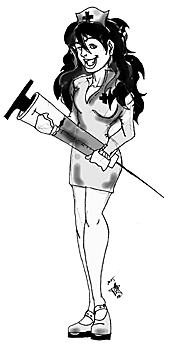
Illustration by Holly Randall
|
|
By Dillon Fishman
Arizona Daily Wildcat
Tuesday, March 29, 2005
Print this
For UA students, the month of March usually means three big things: spring break, March Madness and the ominous approach of final exams. Through all of that, it's easy for us to forget that around the rest of the country and the world, many people live amid suffering and crisis.
As an important reminder of that suffering and the need for humanitarian aid, March is Red Cross Month.
Along with giving the American Red Cross an opportunity to promote its services, celebrate its successes and educate people about its mission, Red Cross Month reminds us of the opportunity to pitch in and do our part to alleviate that suffering and to help combat those crises, both domestically and abroad.
For instance, every two seconds, someone in America requires blood. The Red Cross must collect enough blood donations every day to meet the needs of accident victims, cancer patients and children with blood disorders. Yet the Red Cross and its partners do much more than just collect blood.
The American Red Cross is part of the immense International Red Cross and Red Crescent Movement. That movement is one of the largest humanitarian networks in the world, with a presence and activities in almost every country. All Red Cross and Red Crescent activities have one central purpose: to help those who suffer, without discrimination, whether during conflict, in response to natural or man-made disasters or due to complications of chronic poverty.
That is a purpose worth celebrating and supporting, especially when so many remain in dire conditions.
For example, this month marked three months since the Southeast Asia tsunami disaster, which devastated thousands of miles of coastline around the Indian Ocean. Thousands died. Of the survivors, millions were displaced - their homes destroyed, the infrastructure of their communities ruined.
In Sri Lanka alone, where more than 100,000 families were affected by the tsunami, the American Red Cross distributed supplies extensively along with the Sri Lankan Red Cross and the International Federation of Red Cross and Red Crescent Societies.
Likewise, millions of people, mostly in Africa, are fighting a measles epidemic - something few Americans ever hear about. Measles is the leading vaccine-preventable childhood killer in the world. Each year, 44 million children suffer from measles and 1 million die from it.
The movement's Measles Initiative has vaccinated 150 million children in sub-Saharan Africa, helping to avert more than 300,000 deaths. Each vaccination costs less than $1 and effectively raises a child's chance of survival.
Beyond efforts in places such as Sri Lanka and Africa, the movement does many things including searching for missing persons, helping to establish hospital and security zones in embattled areas, visiting prisoners of war and civilian detainees and providing medical assistance for refugees and other civilian victims of armed conflicts. It also endeavors to promote and strengthen humanitarian law and universal humanitarian principles.
In the United States, the American Red Cross has nearly 900 chapters, including a Southern Arizona Chapter located in Tucson.
In 2002-2003, the Southern Arizona Chapter responded to 184 disasters in Southern Arizona, helping 444 individuals with immediate disaster-caused needs. Sixty percent of these local disaster victims were children. The most common disaster involving Red Cross assistance in our community is fire.
Another important and sadly underemphasized program of the Red Cross is its blood donation services.
Right here in Tucson, we have a chance to volunteer. And many of us students have valuable assets to contribute, such as our time and our blood.
During the school year, donations from high school and college students account for approximately 15 percent of Red Cross blood collections.
But, even though donating blood is easy, safe and takes less than one hour, only five percent of eligible Americans donate blood. To donate blood, one must be healthy, at least 17 years old and weigh 110 pounds or more.
One great attribute of the Red Cross's blood program is its national inventory system, which allows blood to be shuffled from regions with excess supplies to those areas where it is in high demand.
That means that by giving blood in Tucson, we can save lives throughout the nation.
Donors receive free cookies and juice at the end as an added incentive - not to mention cool T-shirts and other prizes for regular donors.
As March draws to a close, let's pledge to assist those who are less fortunate by giving whatever we can to the noble efforts of the American Red Cross.
The nearest chapter is located at 4601 E. Broadway Blvd. just west of Swan Road. Call (520) 318-6740 for information about classes, donating or volunteering.
Dillon Fishman is a third-year law student. He can be reached at letters@wildcat.arizona.edu.
.
